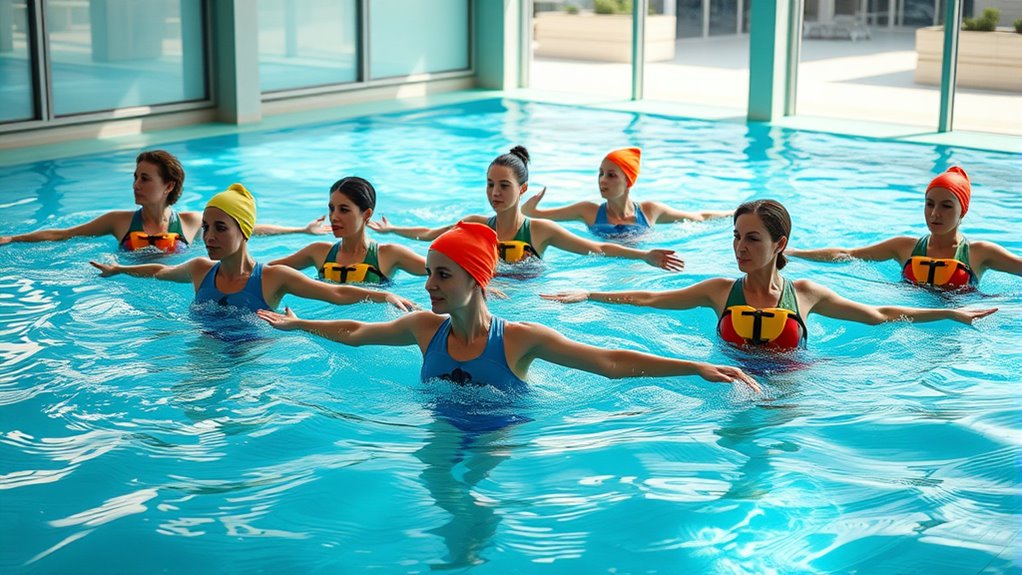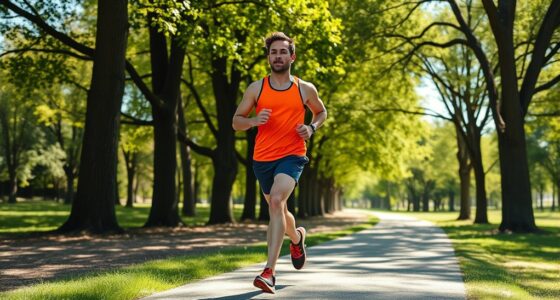To get started with water aerobics, choose a safe, clean pool with water temperatures between 83°F and 88°F for comfort. Wear a secure swimsuit and water shoes for safety, and warm up before exercising. Focus on simple moves like marching, leg lifts, and arm circles, gradually increasing intensity. Keep a routine, set achievable goals, and enjoy varied exercises to stay motivated. If you continue exploring, you’ll discover more tips to make your workouts effective and fun.
Key Takeaways
- Choose a safe, well-maintained pool with appropriate water temperature and space for comfortable movement.
- Wear supportive, snug swimsuits and water shoes to ensure safety and enhance exercise effectiveness.
- Warm up muscles before starting exercises to prevent strains and injury.
- Start with basic routines like marching, leg lifts, and arm circles to build strength and confidence.
- Set realistic goals, track progress regularly, and incorporate fun, varied routines to stay motivated.
Benefits of Water Aerobics for Your Health
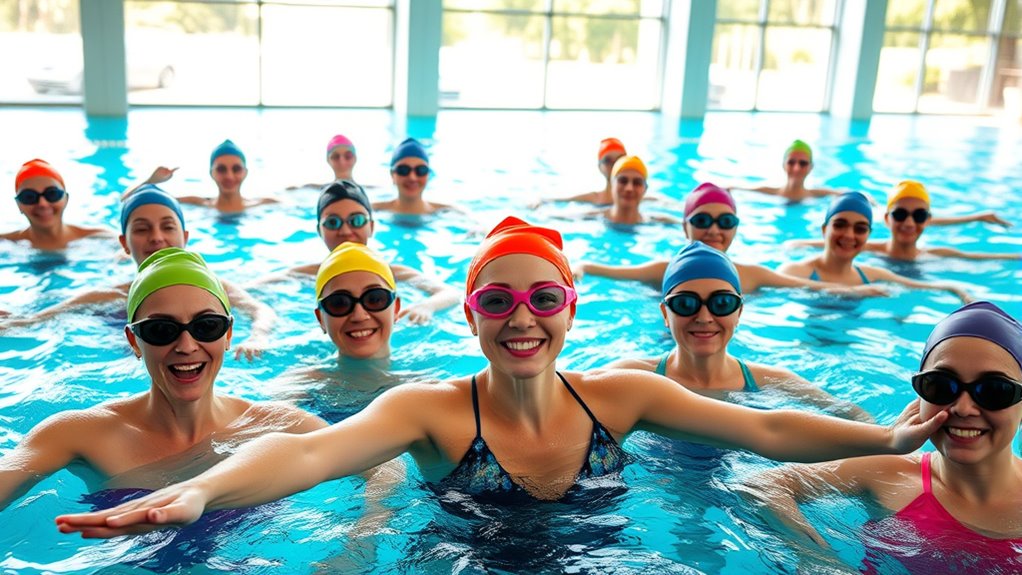
Water aerobics offers numerous health benefits that can improve your overall well-being. One major advantage is enhancing joint mobility, as the water’s buoyancy reduces impact, making movements smoother and less painful. This makes it ideal if you’re recovering from injury or managing arthritis. Additionally, participating in water workouts can boost your mental well-being by reducing stress and elevating mood. The soothing properties of water help you relax, clear your mind, and improve focus. Regular sessions can also increase your strength, flexibility, and cardiovascular health. Furthermore, the beach environment, with its calming waves and gentle breezes, can enhance your workout experience and promote relaxation outside the pool. Overall, water aerobics provides a low-impact, enjoyable way to stay active, support joint health, and foster a positive mental state. Whether you’re a beginner or experienced exerciser, these benefits contribute to a healthier, happier you.
Essential Equipment and Attire for Water Workouts
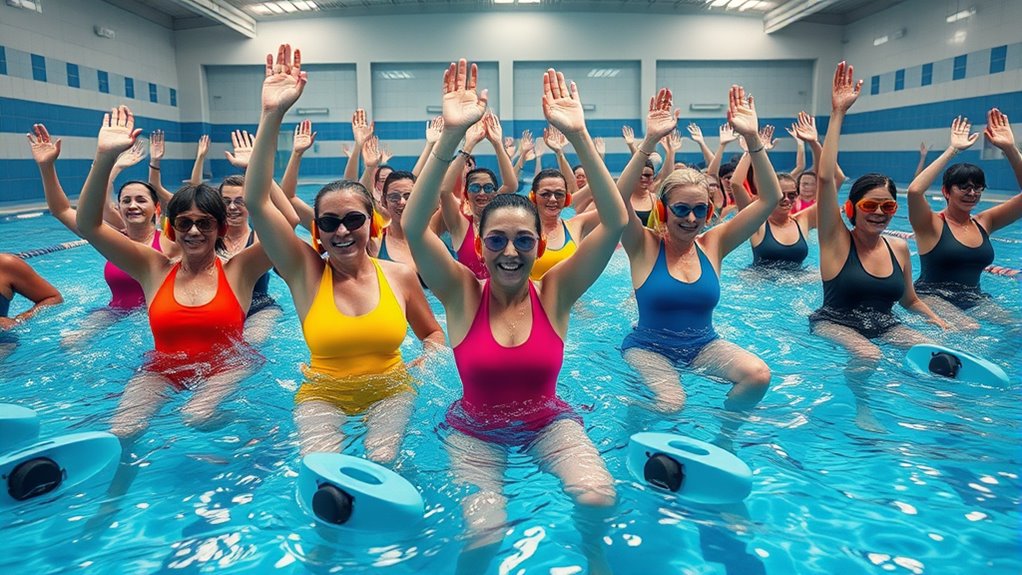
To get the most out of your water workouts, having the right equipment and attire is vital. First, your swimsuit selection matters—choose a secure, snug fit to prevent shifting during movement. Second, water shoes are essential for grip and foot protection, especially on slippery surfaces. Third, consider adding a waterproof towel or a quick-dry cover-up for after your session. A good swimsuit offers comfort and support, while water shoes improve stability and safety. Make sure your attire is made from quick-drying, chlorine-resistant fabric to keep you comfortable throughout your workout. Proper color accuracy in your gear can enhance your overall experience and motivation during water exercises. These essentials help you focus on your exercises without distractions, ensuring a safe and effective water aerobics experience.
Choosing the Right Pool and Environment
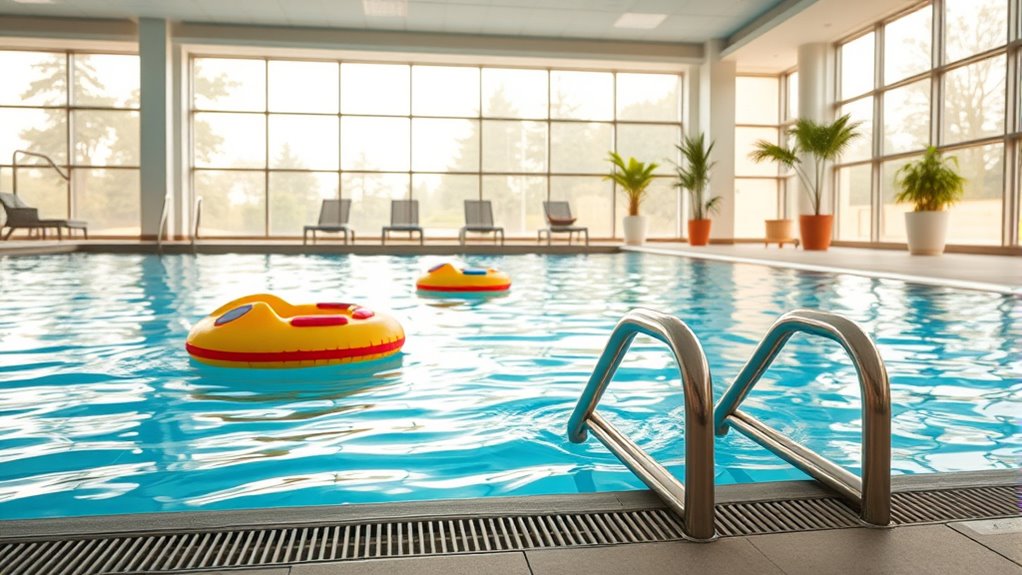
Choosing the right pool and environment can make a significant difference in your water aerobics experience. Look for a pool with good pool cleanliness, as dirty or poorly maintained water can cause discomfort or health issues. The water temperature should be warm enough—ideally between 83°F and 88°F—to keep you comfortable and relaxed during exercise, but not so hot that it causes fatigue. Ensure the pool has ample space for movement without overcrowding, allowing you to focus on your workout safely. A clean, well-maintained environment promotes a more enjoyable session and reduces the risk of infections. Additionally, considering portable camping toilets can be beneficial if you plan outdoor water aerobics sessions or activities around natural water bodies, ensuring comfort and hygiene. By selecting a pool that prioritizes cleanliness and maintains the right water temperature, you’ll set a solid foundation for effective and enjoyable water aerobics.
Basic Water Aerobics Exercises to Get Started
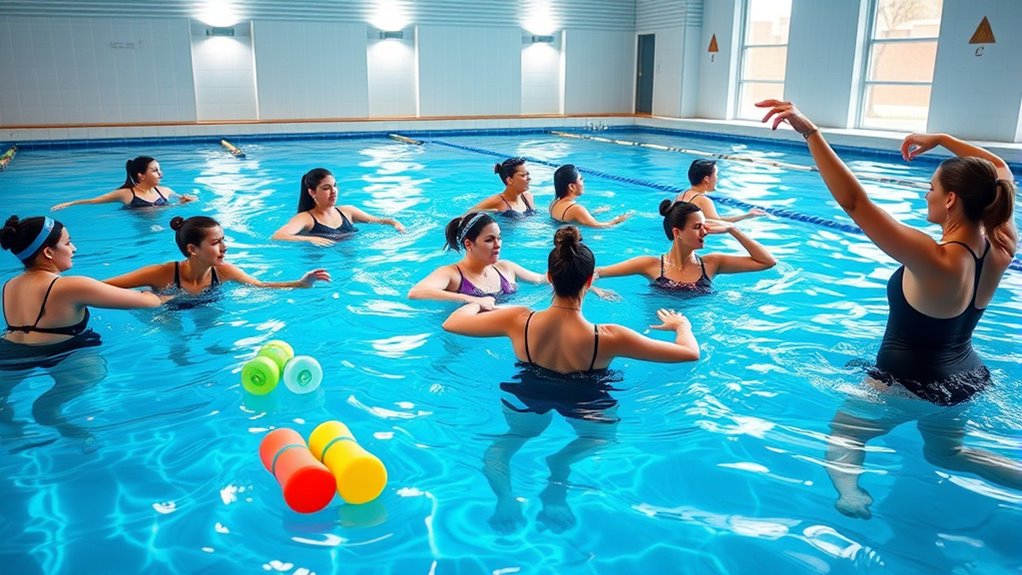
Getting started with water aerobics involves mastering some simple, effective exercises that improve strength, flexibility, and cardiovascular health. These beginner routines leverage water resistance to challenge your muscles in a low-impact way.
Here are three basic exercises to try:
- Marching in Place: Lift your knees high, swinging your arms, to boost heart rate and engage core muscles.
- Leg Lifts: Hold onto the pool edge and lift one leg at a time, working on leg muscles and flexibility.
- Arm Circles: Extend arms and make small circles to build shoulder strength and improve mobility.
These exercises build a solid foundation, making water resistance work for you as you start your water aerobics journey. Incorporating effective resistance into your routine can enhance muscle engagement and overall results.
Safety Tips and Precautions in the Pool
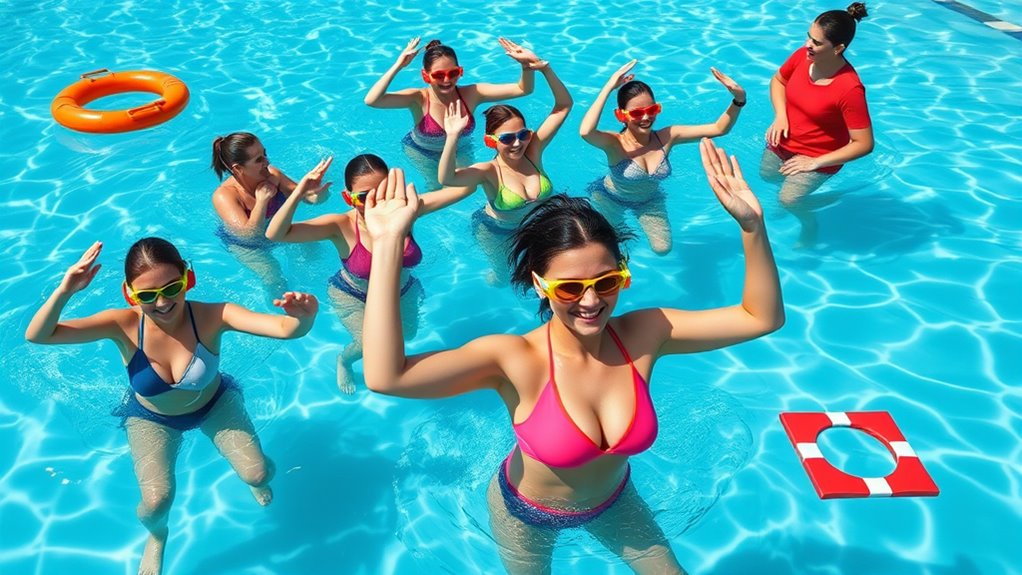
Before starting water aerobics, make sure you’re wearing proper pool attire to stay comfortable and safe. Always warm up your muscles to prevent strains and injuries. Additionally, familiarize yourself with the pool rules to guarantee a safe and enjoyable workout for everyone. Using appropriate safety guidelines can further reduce the risk of accidents during your session.
Proper Pool Attire
Wearing the right pool attire is essential for safety and comfort during water aerobics. Your swimsuit selection affects movement and support, so choose a swimsuit that fits snugly without chafing. Consider these key points:
- Secure Fit: Pick a swimsuit with good support to prevent slips and allow full range of motion.
- Breathable Fabric: Opt for quick-drying, chlorine-resistant material to stay comfortable and avoid skin irritation.
- Poolside Accessories: Use waterproof goggles and a swim cap to protect your eyes and hair from chlorine, plus avoid loose jewelry that could cause injury.
- Proper Material Choices: Selecting self-watering plant pots made from durable, chlorine-resistant materials can prolong their lifespan and ensure safe use in humid environments.
Warm-Up Importance
Did you know that starting your water aerobics session with a proper warm-up can considerably reduce the risk of injuries? A warm-up prepares your muscles and joints, promoting muscle activation and increasing joint flexibility. This helps prevent strains and pulls during more intense exercises. To warm up effectively, incorporate gentle movements like arm circles or leg swings in shallow water. Here’s a quick guide:
| Exercise | Focus Area | Duration |
|---|---|---|
| Arm Circles | Shoulder muscles | 2 minutes |
| Leg Swings | Hip joints | 2 minutes |
| Torso Twists | Core and back | 2 minutes |
| Walking in Water | Overall muscle activation | 3 minutes |
A proper warm-up guarantees your body is ready, safe, and optimized for effective water aerobics. Engaging in warm-up routines can also enhance your overall exercise performance and help you achieve better results.
Know Pool Rules
Have you ever wondered why knowing pool rules is essential for safe water aerobics? Understanding pool etiquette and safety regulations helps prevent accidents and keeps everyone safe. When you enter the pool area, keep these in mind:
- Follow posted rules regarding diving, running, and equipment use.
- Respect others’ space by avoiding rough play or splashing.
- Shower before entering the pool to maintain water quality.
- Being familiar with pool safety guidelines can help you respond appropriately in emergency situations.
Tips for Staying Motivated and Making Progress

To stay motivated and see progress, you should set clear goals that challenge and inspire you. Tracking your workouts helps you recognize improvements and stay focused. Additionally, finding routines you enjoy makes it easier to stay committed and keep moving forward. Incorporating diverse activities can also prevent boredom and keep your water aerobics sessions engaging.
Set Clear Goals
Setting clear goals is essential for staying motivated and tracking your progress in water aerobics. When you practice goal setting, you create a roadmap that keeps you focused and driven. To effectively set goals, consider these steps:
- Define specific achievements, like completing a certain number of classes weekly.
- Set measurable targets, such as improving endurance or increasing repetitions.
- Establish realistic timeframes to reach milestones, keeping motivation strategies in check.
Track Your Progress
Tracking your progress is key to staying motivated and noticing improvements in your water aerobics routine. Regular progress tracking helps you see how far you’ve come, reinforcing your commitment. Use a simple log to record workout duration, intensity, and how you feel after each session. Incorporate goal setting by adjusting your targets as you improve. Here’s a sample progress table:
| Date | Workout Duration | Achieved Goal? |
|---|---|---|
| 2024-04-01 | 30 minutes | Yes |
| 2024-04-08 | 35 minutes | Yes |
| 2024-04-15 | 40 minutes | No |
| 2024-04-22 | 45 minutes | Yes |
| 2024-04-29 | 50 minutes | Yes |
Use this data to stay motivated and refine your goals, ensuring continuous progress. Additionally, understanding progress tracking methods can help you optimize your routine and stay focused on your fitness journey.
Find Enjoyable Routines
Finding routines you genuinely enjoy is essential for staying motivated in water aerobics. When you choose fun routines with engaging movements, exercise feels less like a chore and more like an exciting activity. To keep things fresh, try:
- Incorporating dance-inspired moves that make you smile.
- Mixing up high-energy routines with slower, relaxing exercises.
- Adding water props like noodles or weights for variety and challenge.
These options help you stay engaged and look forward to each workout. Enjoyable routines boost your enthusiasm and make it easier to stick with your progress. Remember, the key is to find activities that excite you—whether it’s rhythmic movements or playful challenges—so water aerobics remains a fun and rewarding part of your routine.
Incorporating Water Aerobics Into Your Fitness Routine
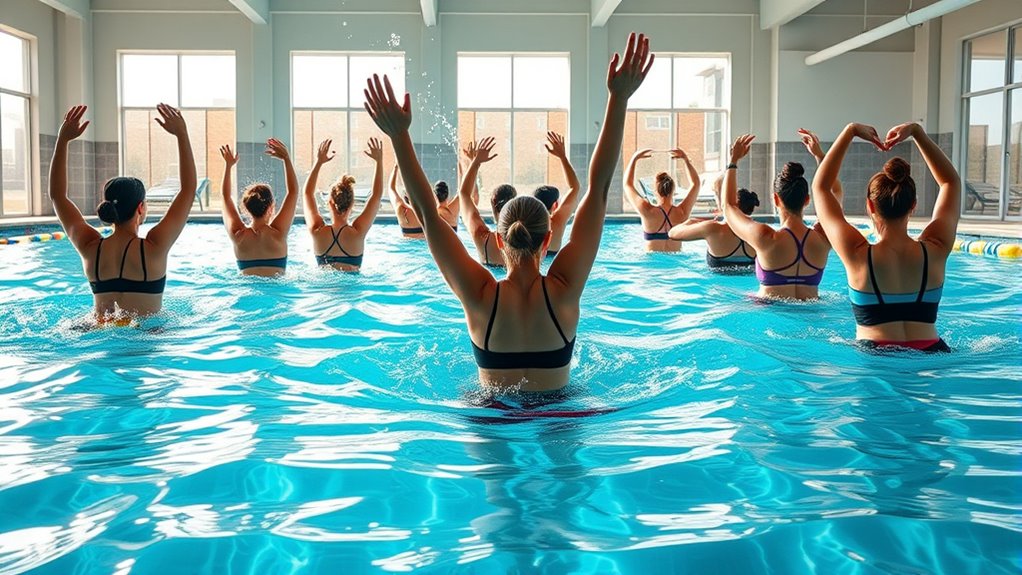
Adding water aerobics to your fitness routine can be an invigorating way to stay active while reducing joint strain. The water’s natural resistance challenges your muscles without overloading your joints, thanks to water buoyancy. To incorporate it effectively, schedule regular sessions and vary your exercises—mixing cardio, strength, and flexibility. Use water resistance to intensify movements, making each workout more effective. Consider setting goals, like improving endurance or toning specific muscles. Remember, consistency is key. You can complement water aerobics with land-based workouts, or do it alone. Here’s a simple plan:
| Week | Focus | Duration |
|---|---|---|
| 1-2 | Building stamina | 30 minutes |
| 3-4 | Increasing intensity | 40 minutes |
| 5+ | Maintaining progress | 45 minutes |
Frequently Asked Questions
How Often Should I Do Water Aerobics for Optimal Results?
To see the best results, aim for exercise frequency of at least three to five times a week. Consistency is key, so sticking to a regular workout schedule helps you build endurance, strength, and flexibility. Water aerobics is gentle on your joints, making it suitable for frequent sessions. Listen to your body and gradually increase intensity to maintain workout consistency without risking injury.
Can I Do Water Aerobics if I Have Joint or Mobility Issues?
Yes, you can do water aerobics even with joint or mobility issues. Water provides joint-friendly exercises that reduce impact and support your mobility support strategies. You’ll find that the buoyancy helps ease pain and improve movement, making it easier to stay active. Just start with gentle routines, listen to your body, and consult your healthcare provider to guarantee your workouts are safe and effective for your needs.
Are There Specific Water Depths Suitable for Beginners?
Sure, you’ll love trying to find the perfect water depth—because who doesn’t enjoy the thrill of guessing? For beginners, shallow water or beginner-friendly zones are ideal, usually waist to chest deep. These depths provide stability and confidence, making it easier to learn moves and avoid slips. So, pick a zone that feels comfortable; it’s your safe space to start building strength without the risk of sinking or feeling overwhelmed.
How Can I Modify Exercises for Different Fitness Levels?
To modify exercises for different fitness levels, you should focus on exercise modifications and intensity adjustments. For beginners, lower the impact, reduce range of motion, or slow down movements. For advanced participants, increase resistance or speed for more challenge. Listen to your body, and don’t hesitate to tailor exercises based on comfort and ability. These adjustments guarantee everyone gets a safe, effective workout, regardless of fitness level.
What Should I Do if I Experience Discomfort During the Workout?
If you feel discomfort during your workout, stop immediately to prevent injury. For example, Sarah felt pain in her shoulder, so she paused and adjusted her arm movements. To manage discomfort and promote injury prevention, listen to your body, modify or skip exercises causing pain, and stay hydrated. Remember, discomfort isn’t normal—prioritize your safety to enjoy water aerobics and stay injury-free.
Conclusion
Now that you’re armed with the essentials, plunge into water aerobics like a fish in its natural habitat. Let each splash and stroke lift your spirits and strengthen your body, turning the pool into your personal playground. Embrace the rhythm of movement beneath the surface, and watch your fitness journey ripple outward with confidence. Remember, every splash is a step toward a healthier, happier you—so dive in and make waves!
